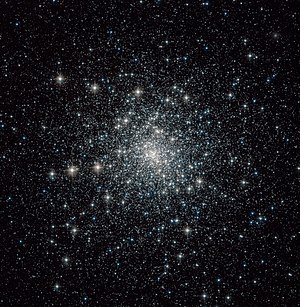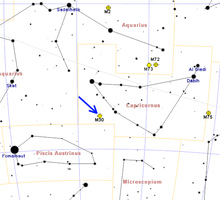
Back Messier 30 Afrikaans مسييه 30 Arabic Cúmulu globular M30 AST NGC 7099 Azerbaijani M30 (аб’ект Месье) Byelorussian M30 BE-X-OLD M30 (звезден куп) Bulgarian Messier 30 BS Messier 30 Catalan NGC 7099 CE
| Messier 30 | |
|---|---|
 Open cluster Messier 30 in Capricornus | |
| Observation data (J2000 epoch) | |
| Class | V[1] |
| Constellation | Capricornus |
| Right ascension | 21h 40m 22.12s[2] |
| Declination | –23° 10′ 47.5″[2] |
| Distance | 27.14 ± 0.65 kly (8.3 ± 0.20 kpc)[3][4] |
| Apparent magnitude (V) | 7.2[5] |
| Apparent dimensions (V) | 12'.0 |
| Physical characteristics | |
| Mass | 1.6×105[6] M☉ |
| Metallicity | = –2.27[7] dex |
| Estimated age | 12.93 Gyr[8] |
| Other designations | M30, NGC 7099, GCl 122[9] |
Messier 30 (also known as M30, NGC 7099, or the Jellyfish Cluster) is a globular cluster of stars in the southeast of the southern constellation of Capricornus, at about the declination of the Sun when the latter is at December solstice.[a] It was discovered by the French astronomer Charles Messier in 1764, who described it as a circular nebula without a star. In the New General Catalogue, compiled during the 1880s, it was described as a "remarkable globular, bright, large, slightly oval." It can be easily viewed with a pair of 10×50 binoculars,[10] forming a patch of hazy light some 4 arcminutes wide that is slightly elongated along the east–west axis.[10] With a larger instrument, individual stars can be resolved and the cluster will cover an angle of up to 12 arcminutes across graduating into a compressed core about one arcminute wide that has further star density within.[11]
It is longest observable (opposed to the Sun) in the first half of August.[b][10]
M30 is centered 27,100 light-years away from Earth with a roughly 2.5% margin of error,[4] and is about 93 light-years across.[11] The estimated age is roughly 12.9 billion years[8] and it forms a mass of about 160,000 times the mass of the Sun (M☉).[6] The cluster is following a retrograde orbit (against the general flow) through the inner galactic halo, suggesting that it was acquired from a satellite galaxy rather than forming within the Milky Way.[8] It is in this epoch 22.2 kly (6.8 kpc), from the center of the galaxy, compared to an estimated 26 kly (8.0 kpc) for the Sun.[12]
The cluster has passed through a dynamic process called core collapse and now has a concentration of mass at its core of about a million times the Sun's mass per cubic parsec. This makes it one of the highest density regions in the Milky Way galaxy. Stars in such close proximity will experience a high rate of interactions that can create binary star systems, as well as a type of star called a blue straggler that is formed by mass transfer.[3] A process of mass segregation may have caused the central region to gain a greater proportion of higher mass stars, creating a color gradient with increasing blueness toward the middle of the cluster.[13]

- ^ Cite error: The named reference
hcob849_11was invoked but never defined (see the help page). - ^ a b Cite error: The named reference
aj140_6_1830was invoked but never defined (see the help page). - ^ a b Cite error: The named reference
apj657_1_286was invoked but never defined (see the help page). - ^ a b Cite error: The named reference
aa555_36was invoked but never defined (see the help page). - ^ "Messier 30". SEDS Messier Catalog. Archived from the original on 30 March 2023. Retrieved 28 April 2022.
- ^ a b Cite error: The named reference
mnras392_1_113was invoked but never defined (see the help page). - ^ Cite error: The named reference
apj742_1_51was invoked but never defined (see the help page). - ^ a b c Cite error: The named reference
mnras404_3_1203was invoked but never defined (see the help page). - ^ Cite error: The named reference
simbadwas invoked but never defined (see the help page). - ^ a b c Cite error: The named reference
jbaa118_4_231was invoked but never defined (see the help page). - ^ a b Cite error: The named reference
omeara1998was invoked but never defined (see the help page). - ^ Cite error: The named reference
aj117_1_277was invoked but never defined (see the help page). - ^ Cite error: The named reference
aj119_3_1259was invoked but never defined (see the help page).
Cite error: There are <ref group=lower-alpha> tags or {{efn}} templates on this page, but the references will not show without a {{reflist|group=lower-alpha}} template or {{notelist}} template (see the help page).
© MMXXIII Rich X Search. We shall prevail. All rights reserved. Rich X Search
![{\displaystyle {\begin{smallmatrix}\left[{\ce {Fe}}/{\ce {H}}\right]\end{smallmatrix}}}](https://wikimedia.org/api/rest_v1/media/math/render/svg/4c0821bd80891e071c08e7c7ee8e022baedf522c)